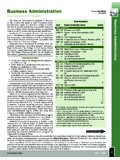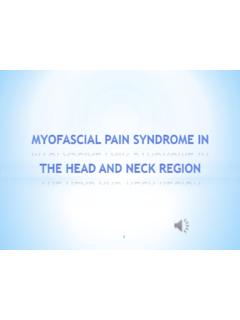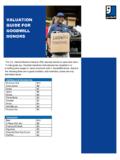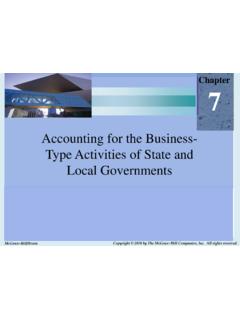Transcription of Accounting for Health Care Organizations - MCCC
1 Copyright 2010 by The McGraw-Hill Companies, Inc. All rights reserved. McGraw-Hill/IrwinChapter17 Accounting for Health care Organizations17-2 Learning ObjectivesAfter studying Chapter 17, you should be able to: Identify different organizational forms and the related authoritative Accounting literature for Health care Organizations Describe financial reporting for Health care organizations17-3 Explain unique Accounting and measurement issues in Health care Organizations , including Accounting for revenues, assets, expenses, and liabilities Journalize transactions and prepare the basic financial statements for not-for-profit and governmental Health care organizationsLearning Objectives (Cont d)
2 17-4 Learning Objectives (Cont d) Describe other Accounting issues in the Health care industry: Budgeting and costs Auditing Taxation and regulation Prepaid Health care services Continuing care retirement communities Explain financial and operational analysis of Health care organizations17-5 Health care Organizations , Such As Hospitals, Can be Structured AsFor-Profit:ProprietaryNot-for-Profit:B usinessOrientedGovernmental:Public17-6 Health care Organizations (HCOs) Types of services Clinics and individual or group practices Continuing care retirement communities (CCRCs) Health maintenance Organizations (HMOs) Home Health agencies Hospitals Nursing homes Rehabilitation centers Parent companies that oversee Health care services17-7 GAAP for a HCO Depends Upon Its Organizational StructureFor-Profit:ProprietaryNot-for-P rofit:BusinessOrientedGovernmental.
3 PublicFASBG uidanceGASBG uidanceAICPA Audit and Accounting GuideHealth care Organizations17-8 GAAP for HCOs Governmental Health care Organizations follow GASB standards and are considered special purpose governments that may be: component units of another government, or stand-alone governmental entities These governmental entities may be engaged in either governmental or business-type activities or both17-9 GAAP for HCOs Not-for-profit (NPO) Health care Organizations report using SFAS No. 117 All Health care Organizations also follow the AICPA Audit and Accounting Guides, as category (b) authority after appropriate FASB and GASB statements which are category (a) authority17-10 Optional Fund Accounting For NPOs and Business-type Governmental HCOs HCOs may choose to use fund Accounting for internal purposes The following funds are used for internal purposes: General Unrestricted Funds Donor-Restricted Funds.
4 Specific Purpose Fund Plant Replacement and Expansion Fund Endowment17-11 Accounting Issues that Differ Depending Upon Organizational Structure Reporting entity Contributions Financial statement displays Cash flows Deposits and investments Compensated absences Debt refunding; risks and uncertainties Pensions and other post retirement benefits Fair value measurements17-12 Financial Statements for HCOs Balance sheet or statement of net assets (see Ill. 17-3) Statement of operations (see Ill. 17-4) Statement of changes in net assets (see Ill.)
5 17-4) Statement of cash flows (see Ill. 17-5 and 17-6)17-13 Equity Reported on the Balance SheetNPO unrestricted net assets; temporarily restricted net assets; and permanently restricted net assetsGovernmental unrestricted net assets; restricted net assets; invested in capital assets, net of related debtFor-Profit capital stock and retained earnings17-14 Nonprofit Health care entities must include a a performance indicatorin their operating statement The purpose of reporting a performance indicator is to provide an operating measure comparable to income from continuing operations of a for-profit Health care entity Aids in comparing the performance across Health care Organizations with different organizational forms Performance Indicator17-15 Examples of a performance
6 Indicator include: Excess of revenues over expenses Excess of revenues and gains over expenses and losses Earned income Performance earningsPerformance Indicator (Cont d)17-16 Performance Indicator (Cont d) Includein the performance indicator: investment income, realized gains and losses, unrealized gains and losses on trading securities Exclude from the performance indicator (among others): transactions with owners, receipt of restricted contributions, restricted investment income17-17 Principle Sources of revenue for a HCO Patient service revenue Government ( , Medicare/Medicaid) Third party payors ( , BC/BS) Premium revenue from capitation fees ( , fixed fees per person paid periodically regardless of services provided) Resident service revenue ( , maintenance or rental fees) Other revenue ( , auxiliary services , investment income, unrestricted contributions)
7 Net assets released from restrictions (for NPOs)17-18 revenue (Cont d) Patient service revenue is reported net of contractual adjustments ( , differences between gross charges and the amount to be paid by third party payors) Charity service to indigent patients for which payment is never expected is notrecorded, but may be reported in the notes to the financial statements17-19 revenue (Cont d) Prepaid Health care plans that earn revenue from agreements to provideservice record revenue at the point agreements are made, not when services are rendered Payment often comes from third-party payors, Medicare, or Blue Cross or private insurance companies according to allowable costs or predetermined (prospective) rates for services17-20 revenue (Cont d)
8 Government Organizations must report operating and nonoperating activities, NPOs may optionally report Operating income, which arises from ongoing major activities, such as service revenue Nonoperating income, which arises from transactions peripheral or incidental to the delivery of Health care , such as investment income and unrestricted contributions17-21 revenue (Cont d) NPOs report donated services and supplies at their fair value, if material and criteria are met NPOs and governmental Organizations report donated noncash assets at their fair value17-22 Assets Current assets (including receivables with related allowance accounts for contractual adjustments and bad debts)
9 Assets limited as to use assets of NPOs limited by contracts or agreements with outside parties other than donors or grantors, as well as limitations placed on assets by the board Investments (at fair value) Noncurrent assets ( , plant, property and equipment)17-23 Use accrual Accounting Bad debts An expense for not-for-profit and for-profit Organizations A reduction of gross revenue for governmental Organizations Depreciation is recorded on capital assets Expenses can be reported by natural classification ( , line items such as salaries and supplies)
10 Or functional categories, such as inpatient services and fiscal and administrative servicesExpenses17-24 Malpractice claims Risk contracting Third-party payor payments Obligations to provide uncompensated care Contractual agreements with physicians As well as others incurred in any businessCommitments and Contingencies17-25 Budgeting and Costs All Health care Organizations should use comprehensive budgets for managerial purposes Only governmental Health care Organizations using governmental funds record budgets in the fund

















